Defending and attacking when overloaded
A progressive, multi-directional drill, this session is based around players attacking quickly whilst recognising and exploiting the space to finish with a shot on goal.
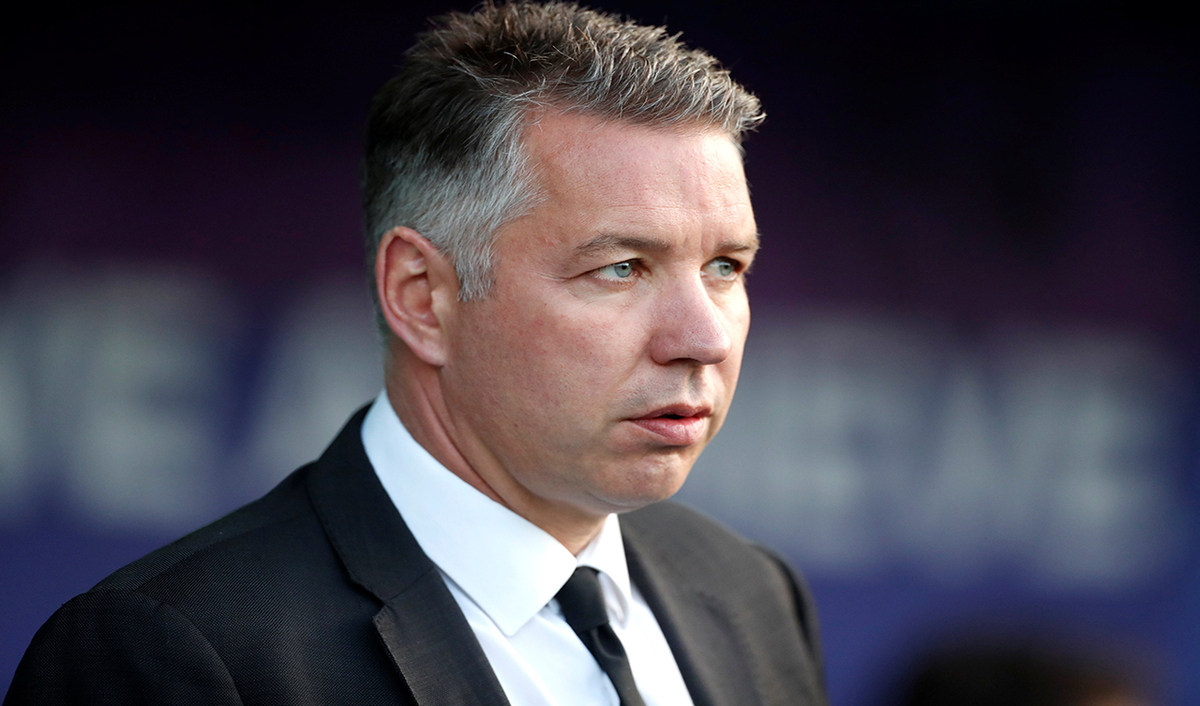
| Area | 30x20 yards |
| Equipment | Balls, bibs, cones, 2 goals |
| No. of Players | 8 players + 2 goalkeepers |
| Session Time |
Session: 30mins |
A progressive, multi-directional drill, this session is based around players attacking quickly whilst recognising and exploiting the space to finish with a shot on goal. They must then immediately transition to defence, recovering quickly to get behind the ball and approach it with the correct body shape to show the opposition around, not through.
A high intensity activity, it consistently mirrors the tempo that our players need to perform at. It also stretches the players in terms of the psychological aspects of the game because there is a constant flow to the session that requires players to attack and make clear decisions and then switch to a defending situation and again make the correct decisions whilst being overloaded.
The continuous flow of the session ensures we are getting the required physical outputs, whilst also ensuring good player engagement.
We use this as a reminder session to get players working at the intensity we require. It would be used on a match day -3/-4 and the focus would be on the physical aspect of the practice, as well as the technical and tactical details required within our playing principles.
OVERLOAD GAME
We set up a playing area of 30x20 yards with a goal and a goalkeeper at each end. We’re using eight outfield players split into two teams of four. The reds start either side of the goal at one end of the playing area and the blues start either side of the goal at the other end.
One blue player starts by dribbling into the playing area and attacking the opposite goal, trying to score past the goalkeeper, as shown [1a].
1a
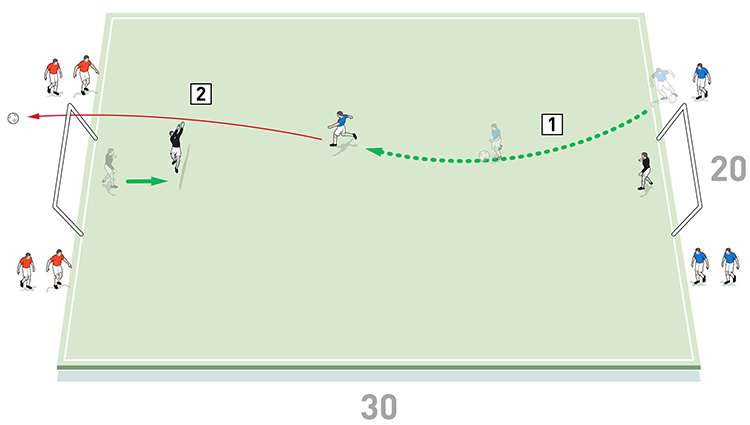
2. The solo blue scores past the red goalkeeper
Once the blue player has shot he must quickly get back to defend his goal against two red players who attack the blue player in a 2v1, as shown [1b].
1b

2. Two reds join the play and attack the blue player in a 2v1, combining to get past and shoot at goal
Now two more blues join the active blue player to attack the reds in a 3v2, with the aim of scoring in the goal that the reds are defending, as shown [1c]. Once the blue attack is dead, the remaining pair of waiting red players join their two active team mates to attack the blue players in a 4v3, as shown [1d], scoring in the goal that the blues are defending.
1c
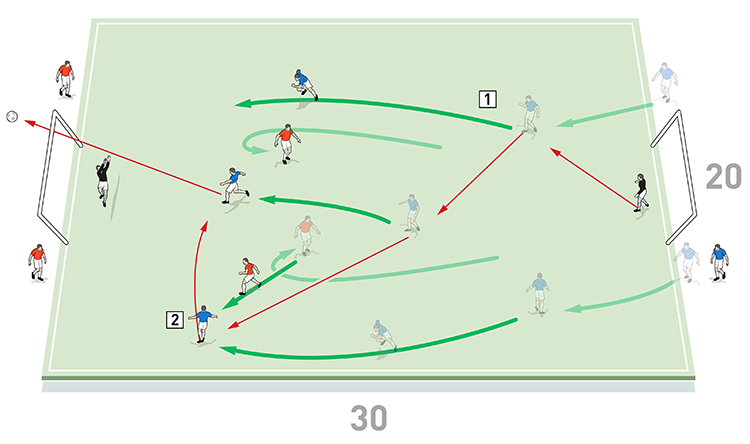
2. Here the blues make well-timed overlapping runs to set up a goal scoring opportunity
1d
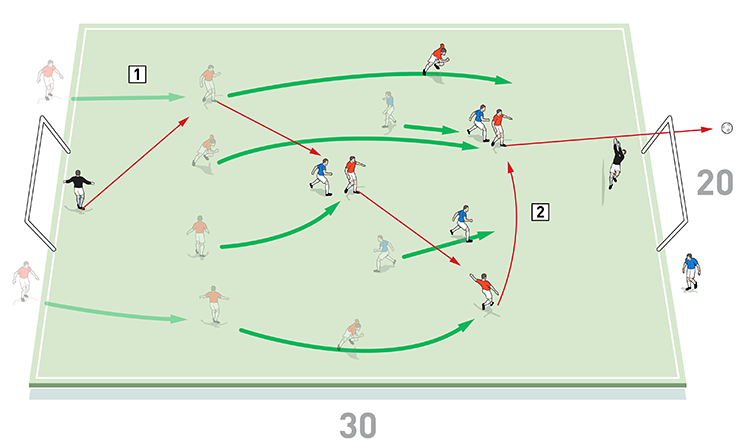
2. The reds use their overload to get past the three recovering blues and score
Finally, the remaining blue player joins the play to make it a 4v4 attack against the goal that the reds are defending, as shown [1e].
1e
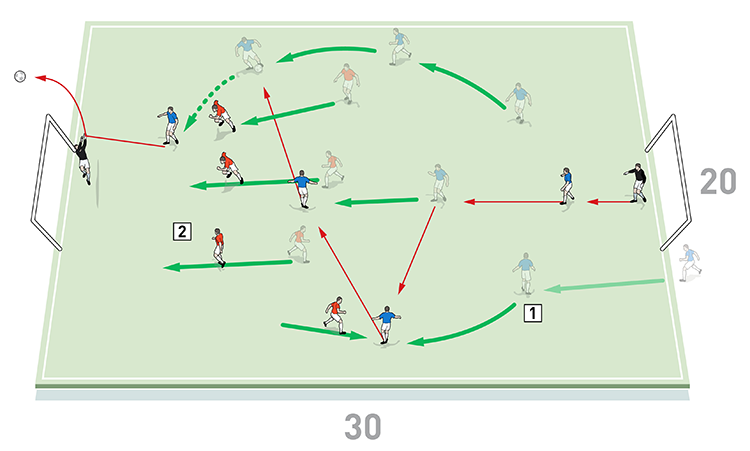
2. The four reds must quickly recover and try to stop the blues scoring
This can be competition based – we keep score and the team with the most goals is the winner. We would first run two seven-minute games with a two-minute rest break, followed by three three-minute games with one minute’s rest between games.
I would explain the session to the players beforehand, outlining the key points that we are looking for because I don’t want to stop the flow or the intensity of the session once the game is underway.
If we decide that we are not getting the required outcomes, in terms of intensity and quick decision making, then we would put a time limit of six seconds on the attacking team to finish their attack. This hopefully would ensure a high intensity game and players would have to make the correct decisions quickly.
COACHING POINTS
What are the key things to look out for?
When in possession, we want to see players attacking with pace and making decisions quickly, plus using the correct timing and detail in passing and making well-timed overlapping and underlapping runs. Calmness in finishing is also vital, with players needing to demonstrate composure to find the corners of the goal.
When out of possession, we want to see players using clear and concise communication and remembering a ‘fast-slow-side-low’ approach when getting up to the ball. Players should show that they know how to delay and to use the correct body position when doing so, showing attackers outside.
What are the typical mistakes players might make and how do I avoid them?
Some players can show a reluctance to defend aggressively and get up to the ball when required. Sometimes they fail to defend with the correct distances between the defender and the ball.
Another typical mistake is for players to make decisions too slowly when attacking with a numerical advantage and failing to appreciate when a team mate in a more advantageous position.
Editor's Picks
Attacking transitions
Deep runs in the final third
Using the goalkeeper in build-up play
Intensive boxes drill with goals
Penetrating the final third
Creating and finishing
My philosophy
Pressing initiation
Compact team movement
Coaches' Testimonials

Alan Pardew

Arsène Wenger

Brendan Rodgers

Carlos Carvalhal

José Mourinho

Jürgen Klopp

Pep Guardiola

Roy Hodgson

Sir Alex Ferguson

Steven Gerrard
Coaches' Testimonials

Gerald Kearney, Downtown Las Vegas Soccer Club

Paul Butler, Florida, USA

Rick Shields, Springboro, USA

Tony Green, Pierrefonds Titans, Quebec, Canada
Join the world's leading coaches and managers and discover for yourself one of the best kept secrets in coaching. No other training tool on the planet is written or read by the calibre of names you’ll find in Elite Soccer.
In a recent survey 92% of subscribers said Elite Soccer makes them more confident, 89% said it makes them a more effective coach and 91% said it makes them more inspired.
Get Monthly Inspiration
All the latest techniques and approaches
Since 2010 Elite Soccer has given subscribers exclusive insight into the training ground practices of the world’s best coaches. Published in partnership with the League Managers Association we have unparalleled access to the leading lights in the English leagues, as well as a host of international managers.
Elite Soccer exclusively features sessions written by the coaches themselves. There are no observed sessions and no sessions “in the style of”, just first-hand advice delivered direct to you from the coach.









